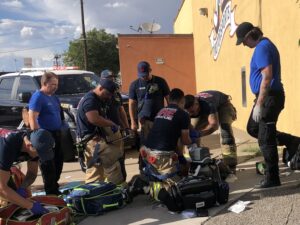WASHINGTON — As the number of dairy cows infected with a strain of bird flu virus grows across the country, 17 of Missouri’s roughly 60,000 dairy cows have been tested while agriculture officials and farmers keep watch for signs that the outbreak has entered the state.
So far, Missouri farmers haven’t reported any cows with the virus, called H5N1, state officials said.
However, national biosecurity and public health experts are concerned that a lack of testing in states across the country, and the economic implications of quarantining cattle, may be allowing the virus to spread undetected.
“You want to work on the assumption that it’s there, and you’re trying to find it,” said Amesh Adalja, a senior scholar at Johns Hopkins Center for Health Security, who focuses on pandemic policy and the intersections of infectious disease and national security. Adalja said 17 tests aren’t enough to give him confidence that Missouri’s herds are virus-free.
“Just because you’re not looking, doesn’t mean it’s not there, that you’re going to avoid the consequences,” Adalja said.
Missouri State Veterinarian Steve Strubberg acknowledged that only a small fraction of the state’s dairy cows have been tested for the virus. Strubberg, who leads the Missouri Department of Agriculture Animal Health Division, said he believes Missouri farmers would have reported sick cows to their veterinarians if their herds were becoming infected.
Because H5N1 is a “Reportable Disease,” veterinarians and laboratories are required to disclose detections. However, while farmers are encouraged to report H5N1 symptoms, it’s not a requirement because there is no confirmation they are ill with the H5N1 virus.
“We just feel like most livestock producers, they really do a great job of watching the health of their animals,” Strubberg said. “I mean, it’s their livelihood.”
Health experts investigating the H5N1 outbreaks in Texas and Colorado told The Associated Press that because labs must report positive results to agriculture departments, many farmers may decide against testing and try to outlast the outbreak to avoid a negative stigma.
In dairy cattle, the virus causes low appetite and reduced milk production, and the milk can have an abnormal appearance. Occasionally, farmers have cows with similar symptoms, which can also be caused by other diseases.
While H5N1 is associated with high mortality rates in poultry, reports indicate infected dairy cattle rarely die. Even when cows in a herd become sick, they seem to recover rather quickly after a few weeks, as long as dairy farmers are using disease management procedures, Strubberg said.
Since March 25, when the world first learned H5N1 had developed the ability to infect and spread among cows, infections have been reported so far in at least 140 herds in 12 states – including Missouri’s neighboring states of Kansas and Iowa — according to the USDA dashboard updated July 3.
However, experts say the U.S. Department of Agriculture’s numbers likely underestimate the size of the outbreak because so few cattle are being tested.
Currently, the USDA requires lactating cattle to be tested before being shipped across state lines.
Adalja said that because of the lack of proactive testing, he said he doesn’t believe “anybody in the field would think that those 38 states could be declared non-H5N1 cow (infected) states.”
Historically, when the H5N1 virus has infected people on rare occasions, the death rate has been over 50%. In the current U.S. dairy cattle outbreak, the four farm workers with documented infections have had mild cases, mostly including symptoms of eye redness, following direct contact with sick cows. The most recent human case was announced as of last week.
U.S. Centers for Disease Control and Prevention said the health risk to the general public remains low and has recommended personal protective equipment for those working with infected cows.
While dairy cows have generally recovered during this current outbreak, the virus has proven to be fatal to cats who drank raw milk from infected cows.
U.S. Food and Drug Administration said its tests indicate that the pasteurization process used in commercial milk processing is effective at inactivating the H5N1 virus. While there is concern that the virus can be transmitted to humans through the consumption of unpasteurized, or raw, milk from infected cows, the FDA continues to emphasize its longstanding recommendations about ingesting raw milk because of its potential to be contaminated.
The fact that no farms are reporting symptoms in cows is the best indication that H5N1 is not in Missouri, state officials said. One of the reasons they believe Missouri has avoided the virus is because the state imports so few cows.
Missouri’s tests on 17 dairy cows, as of Monday, occurred because the animals were being moved across state borders. However, it remains unclear how the virus is circulating, and in some states, herds have become infected despite no movements of cattle.
It appears that farm workers may be involved in the outbreak’s spread, but Missouri has minimal shared labor between farms, state officials said.
Even so, in preparation for the 2024 Missouri State Fair, scheduled to begin Aug. 8 in Sedalia, the Missouri Department of Agriculture and Strubberg announced last week updated biosecurity protocols for exhibiting dairy cattle. All lactating dairy cattle must have a negative H5N1 test within seven days before arrival at the Missouri State Fairgrounds.
The Missouri Department of Agriculture has been doing outreach to dairy producers and veterinarians and providing updated information on the virus.
Scott Poock, a dairy and beef cattle veterinarian with the University of Missouri Extension, said he would be confident that Missouri “probably hasn’t had it.”
“Can I say 100%? Absolutely not. Never,” Poock said.
Missouri, like other states, has been battling H5N1 in poultry for some time. And as it remains unclear how the virus jumped from birds to dairy cows, Strubberg said the lack of many new H5N1 detections in Missouri poultry can provide more confidence, to a degree, that the virus isn’t in Missouri cows.
While some experts are concerned about a lack of proactive testing, there is a risk aversion for farmers who would have to quarantine lactating cattle with a positive test. The USDA has taken some actions to help farmers, including offering loans to farmers and livestock producers to alleviate biosecurity measurement costs, such as veterinary and testing expenses.
Like experts in infectious diseases, farmers are aware of the issue but have differing opinions and levels of concern, Strubberg said.
Chloe Collins, an MU Extension dairy field specialist, said that most farmers she has recently spoken with have been optimistic about the H5N1 risk. She said farmers are practicing good biosecurity and are tapping into expert resources. Collins also described the state’s dairy industry as “prepared and resilient.”
Adalja said he believes that the USDA and state agriculture departments are walking a tightrope trying to balance the economic and public health implications. This includes what stigma might occur if a farm tests positive.
“These (cows) are not pets,” Adalja said. “They are economic vessels, basically, that are important for the economies of those farms, the economies of those counties and the states.”
This story originally appeared in the Columbia Missourian. It can be republished in print or online.
Our stories may be republished online or in print under Creative Commons license CC BY-NC-ND 4.0. We ask that you edit only for style or to shorten, provide proper attribution and link to our website. AP and Getty images may not be republished. Please see our republishing guidelines for use of any other photos and graphics.





